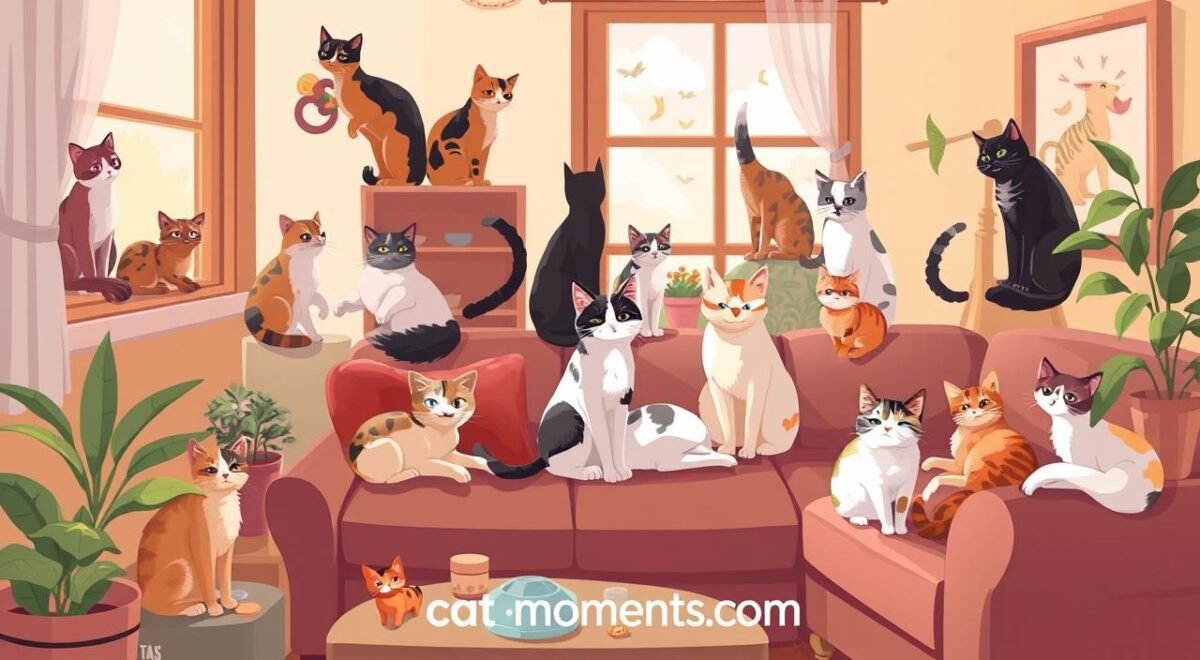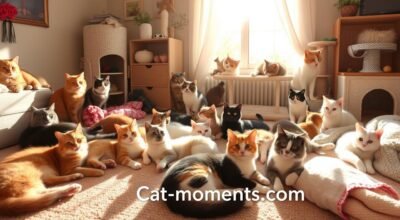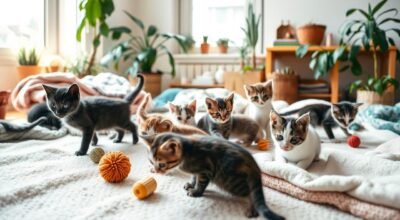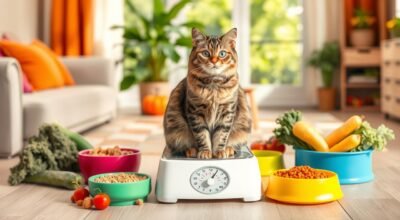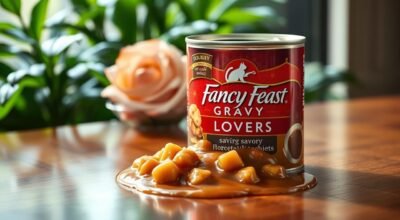Cats are known for their independent nature. Some breeds handle being alone better than others. The International Cat Association (TICA) suggests certain breeds for those with busy lives.
To ease your cat’s stress when you’re away, make sure they’re comfortable. Provide food, water, and a clean litter box. Keep them active with toys and puzzles, and give them space to move around.
Background noise from TV or radio can also help. It makes them feel less alone.
Key Takeaways
- TICA recommends certain cat breeds for individuals living alone or with busy lifestyles
- Ensuring a comfortable environment and providing activities can help mitigate stress during prolonged absences
- Independent cat breeds tend to be self-sufficient and require less constant attention
- Factors like grooming needs, size, and lifespan should be considered when selecting an independent feline companion
- Breeds like Russian Blue, British Shorthair, and Norwegian Forest Cat are known for their solitary nature and adaptability
Understanding Independent Cat Breeds: Essential Traits and Characteristics
Single-pet households and apartment dwellers often choose self-sufficient cat breeds. These cats are perfect for busy lives and simple homes. They have traits that fit well with these lifestyles.
Key Features of Self-Sufficient Cats
Self-sufficient cat breeds are very adaptable. They do well in many places, from small apartments to big houses. They need less attention than some cats, which is great for owners who are always on the go.
Benefits of Independent Feline Companions
Having an independent cat breed has many advantages. They help lower stress for both the cat and the owner. They don’t get anxious when left alone and can handle being by themselves for a long time.
They also fit into busy lives easily. Owners can leave and come back without worrying about their cat. This makes life easier for everyone.
Living Space Requirements
Even though they’re adaptable, self-sufficient cat breeds need some space. They like to climb and explore, so they need vertical spots like shelves or cat trees. Toys and games also keep them happy and engaged in their homes.
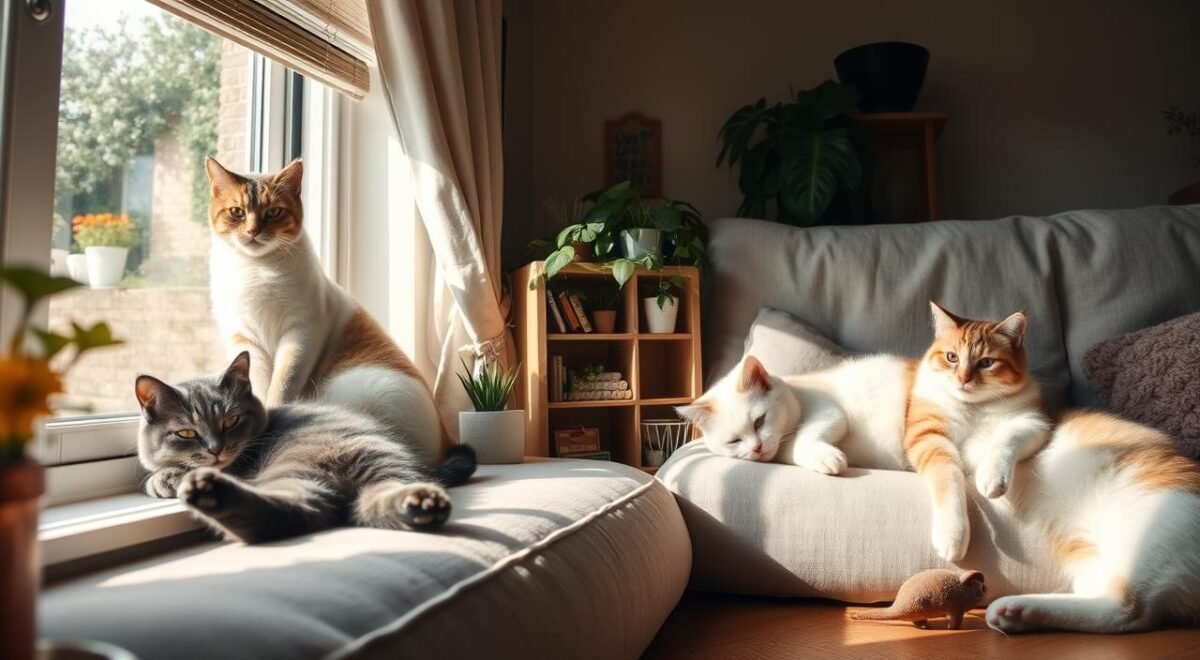
“The ability to entertain themselves and adapt to different living situations makes self-sufficient cat breeds a popular choice for busy individuals and apartment dwellers.”
Which Cat Breeds That Are Best to Live Alone
For those with busy lives or small homes, some cat breeds are perfect. They are independent and don’t need much attention. These cats for busy owners and cat breeds for small spaces are great on their own. They have laid-back cat personalities.
- Russian Blue
- British Shorthair
- Norwegian Forest Cat
- Scottish Fold
- Maine Coon
- Persian
- Ragdoll
- American Wirehair
- Siamese
- Manx
- American Shorthair
- Abyssinian
- Birman
- Exotic Shorthair
- Bengal
- Himalayan
These breeds can keep themselves busy and adapt to different homes. They are perfect for cats for busy owners and those who want a calm pet. They fit well in small apartments or busy homes, offering both companionship and independence.
| Breed | Weight Range (kg) | Lifespan (years) |
|---|---|---|
| Ragdoll | 3.5-9 | up to 15 |
| British Shorthair | 3.2-7.7 | 14-20 |
| Burmese | 3-5 | 16-18 |
| Sphynx | 3.5-7 | 8-14 |
| Siamese | 2.5-6 | 15-20 |
| Bengal | 3.6-6.8 | 12-16 |
| Maine Coon | 3.6-8.2 | up to 14 |
These cat breeds for small spaces and laid-back cat personalities are perfect for busy owners. They are independent and can entertain themselves. They fit well in both small and large homes, offering companionship without much work.
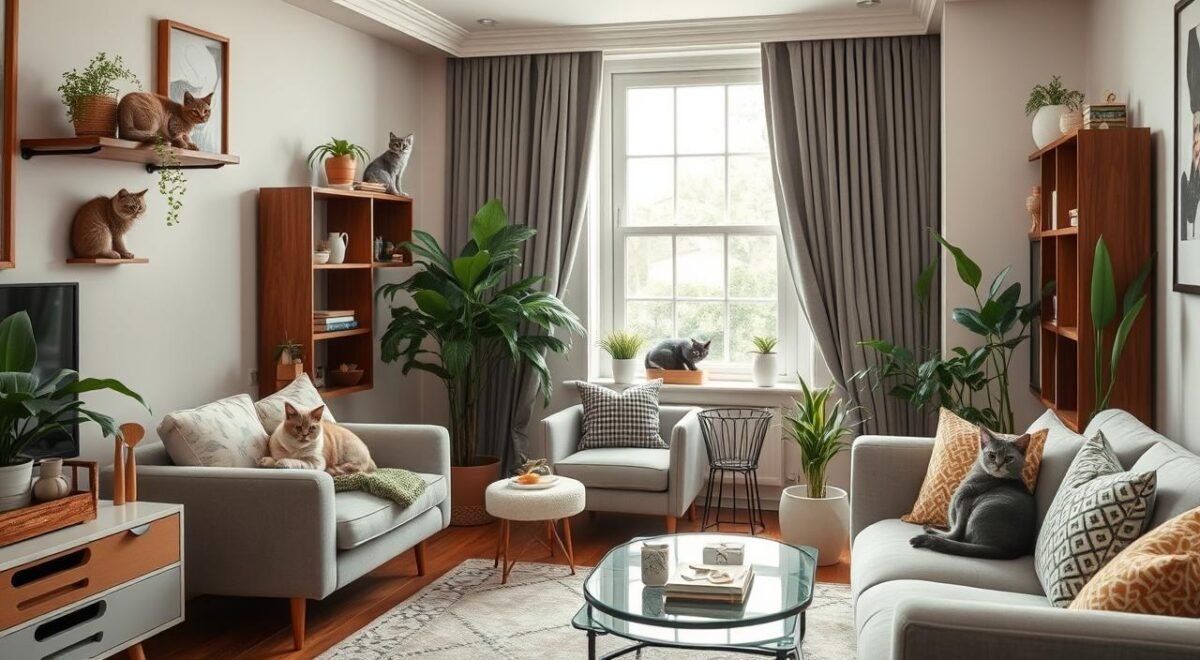
Russian Blue and British Shorthair: Masters of Solitude
Two cats stand out among independent breeds: the Russian Blue and the British Shorthair. They are perfect for busy lives, offering friendship without the need for constant attention.
Russian Blue’s Distinctive Personality Traits
The Russian Blue is calm and loving, with a dark-gray, bluish coat and green eyes. They are Adaptable and love apartment living. Their low-noise level and 15-20 year lifespan make them great friends for those who want a loyal pet.
British Shorthair’s Easygoing Nature
The British Shorthair is also great for those who want a low-maintenance cat. They are Adaptable and enjoy being part of active families. Their low activity level and 12-16 year lifespan mean they are easy to care for.
Care Requirements for Both Breeds
Both breeds need simple care, making them perfect for busy people. They need regular food, occasional grooming, and toys for fun. Their low-maintenance nature and ability to enjoy alone time make them ideal companions.
Norwegian Forest Cat and Maine Coon: Independent Giants
The Norwegian Forest Cat and Maine Coon are two impressive feline breeds. They are perfect for busy owners and small spaces. They are great choices for those who want self-sufficient cats.
Norwegian Forest Cats are known for being friendly and semi-domestic. They can grow up to 18 inches tall and weigh 9 to 16 pounds. These cats are okay with owners being away often and need little attention.
They have long, silky coats that need regular grooming. But, they are generally easy to care for.
Maine Coons are large, patient cats that can entertain themselves for a long time. They can grow up to 40 inches tall and weigh 8 to 20 pounds. Sometimes, they can even weigh 30 pounds.
These cats fit well in different living environments. Their shaggy coats need regular brushing. But, their loving and smart nature makes them great companions for busy owners.
FAQ
What are some cat breeds that are best suited for living alone?
Some cat breeds that do well alone include Russian Blue, British Shorthair, and Norwegian Forest Cat. Also, Scottish Fold, Maine Coon, and Persian cats are good choices. Ragdoll, American Wirehair, and Siamese cats also fit well in single-pet homes. Manx, American Shorthair, Abyssinian, Birman, Exotic Shorthair, Bengal, and Himalayan cats are also great options.
What are the key features of self-sufficient cat breeds?
Independent cat breeds are self-sufficient and low maintenance. They can entertain themselves, making them perfect for busy people. These cats are great for apartments and single-pet homes.
They adapt well to different living spaces. They don’t need constant attention and can handle being alone for a while.
What are the benefits of independent feline companions?
Independent cats reduce stress for both cats and owners. They offer flexibility in daily routines. Leaving them alone doesn’t make owners feel guilty.
These cats are ideal for busy owners, small spaces, and those who want a laid-back pet.
What are the living space requirements for independent cat breeds?
Independent cat breeds can live in apartments and small spaces. They need a comfortable temperature, food, water, and a clean litter box. Meeting these basic needs is key to their happiness.
What are the distinctive personality traits of the Russian Blue and British Shorthair breeds?
The Russian Blue is calm and affectionate, perfect for apartments. The British Shorthair is easygoing and loves being alone, great for active families. Both breeds are low maintenance and handle being left alone well.
How do the Norwegian Forest Cat and Maine Coon compare in terms of independence?
The Norwegian Forest Cat is a friendly giant that gets along well with owners away. The Maine Coon is large and patient, great at entertaining itself. Both breeds are perfect for busy owners and fit well in different homes.
